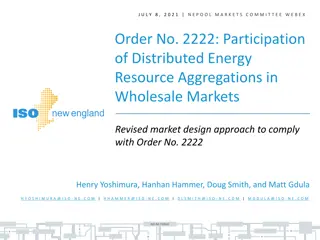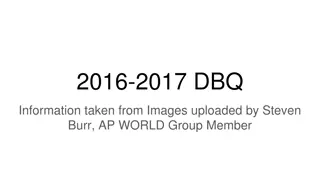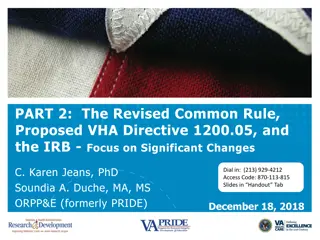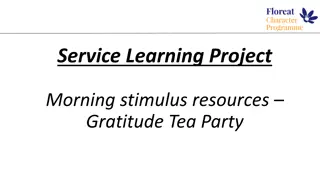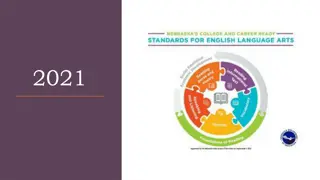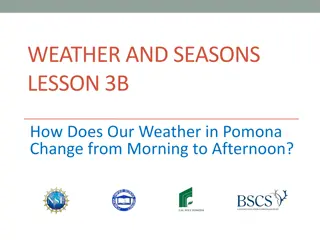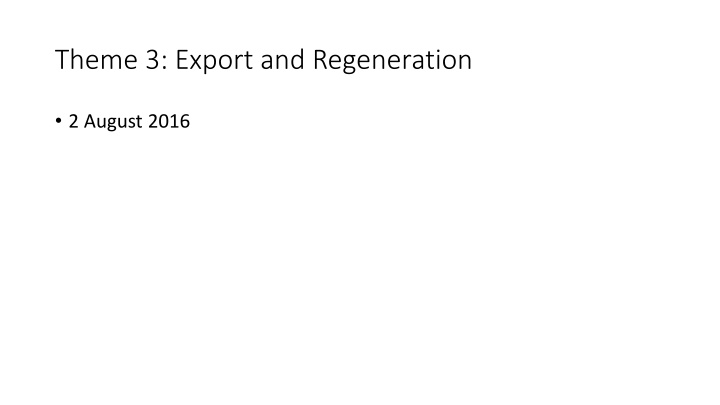
Processes and Rates in Ocean Export and Regeneration
Explore the variations in processes and rates with depth, time, and space, and the importance of biotic versus abiotic factors in export and regeneration. Dive into the complexities of ocean circulation, TEIs regeneration, and environmental impacts on export.
Download Presentation

Please find below an Image/Link to download the presentation.
The content on the website is provided AS IS for your information and personal use only. It may not be sold, licensed, or shared on other websites without obtaining consent from the author. If you encounter any issues during the download, it is possible that the publisher has removed the file from their server.
You are allowed to download the files provided on this website for personal or commercial use, subject to the condition that they are used lawfully. All files are the property of their respective owners.
The content on the website is provided AS IS for your information and personal use only. It may not be sold, licensed, or shared on other websites without obtaining consent from the author.
E N D
Presentation Transcript
Theme 3: Export and Regeneration 2 August 2016
Export and Regeneration 1. How do processes and rates vary with depth? 2. How do processes and rates vary with time and space (e.g. different biogeochemical and physical regimes)? 3. What is the relative importance of biotic versus abiotic processes and rates on export and regeneration? 4. How do processes and rates vary along dissolved-particulate continuum? 5. Do we understand the processes well enough to make predictions about the future and interpret paleorecords?
1. How do processes and rates vary with depth? How can we better define the depth dependence of export and regeneration? Does the depth dependence of processes and rates vary with environmental conditions? Horizontal versus vertical processes (sinking versus subduction) What are particle sinking rates? Changes to TEI/C ratios with depth What are the controls on the different regeneration length scales of different TEIs? (e.g. depth of ferricline versus nitricline) Do different data sets give us the same answer?
2. How do processes and rates vary with time and space (e.g. different biogeochemical and physical regimes)? Seasonal? Longer term scales (global change) to be used for prediction? What are the bounds on some ocean circulation rate processes (overturning of upper thermocline, subduction) in different spatial regimes? How does circulation rates relate to export and regeneration rates? Why are there apparent regional differences in TEI regeneration? How do we separate the effects of regeneration (J) from mixing and transport signals? Can we de-convolve J into its component processes (regeneration/scavenging)? Can we use multiple TEIs? How do we better constrain export using multiple strategies? Compare Th, Ba, TEIs How much is exported, regenerated, recycled What is the relationship between OUR and dissolved TEI distributions? What is the regional dependence? What is the difference between the vertical and horizontal processes Can you differentiate these processes with modeling? What are the mechanisms and rates of regeneration of TEIs in the upper ocean and their sensitivity to environmental conditions? What is the effect of lithogenic inputs on export and regeneration? Source vs. ballast
3. What is the relative importance of biotic versus abiotic processes and rates on export and regeneration? Elemental stoichiometry (regeneration length scales) What is the relative role of biota (bacteria vs. algal vs. zooplankton) in export and regeneration? Zooplankton (euphausids vs. salps)? Type of grazing/migration Fecal pellets How do we better represent the role of ligands in regeneration of TEIs in models? Tease out intermediate phases (leachable particulate) Reversible scavenging of ligands?
4. How do processes and rates vary along dissolved-particulate continuum? What is the relationship between sinking and suspended material? Do the small slow-sinking particles have a role in buffering dissolved distributions Kd How do we de-couple disaggregation (breakup) of particles versus remobilization? How do organic ligands mediate exchange between dissolved and particulate TEI distributions ? Can we parameterize this in models? Do they buffer leachable particulate metals (instead of free metals)
5. Do we understand the processes well enough to make predictions about the future and interpret paleorecords? How would we better represent particle dynamics in models? Parameterizing aggregation/disaggregation dynamics in global models (20 size classes, 1um-) Export (different than martin curve) Integrals of the size distributions (5 or 6 moments): difficult to related to the TEIs Can relate 2nd moment to TEIs scavenging How do we incorporate simple biological processes to better constrain TEI cycling? Sensitivity of export and regeneration to climate change (and vice versa) What are the mechanisms and rates of regeneration of TEIs in the upper ocean and their sensitivity to environmental conditions? Changes in krill, salps abundance (changes to export efficiency)





